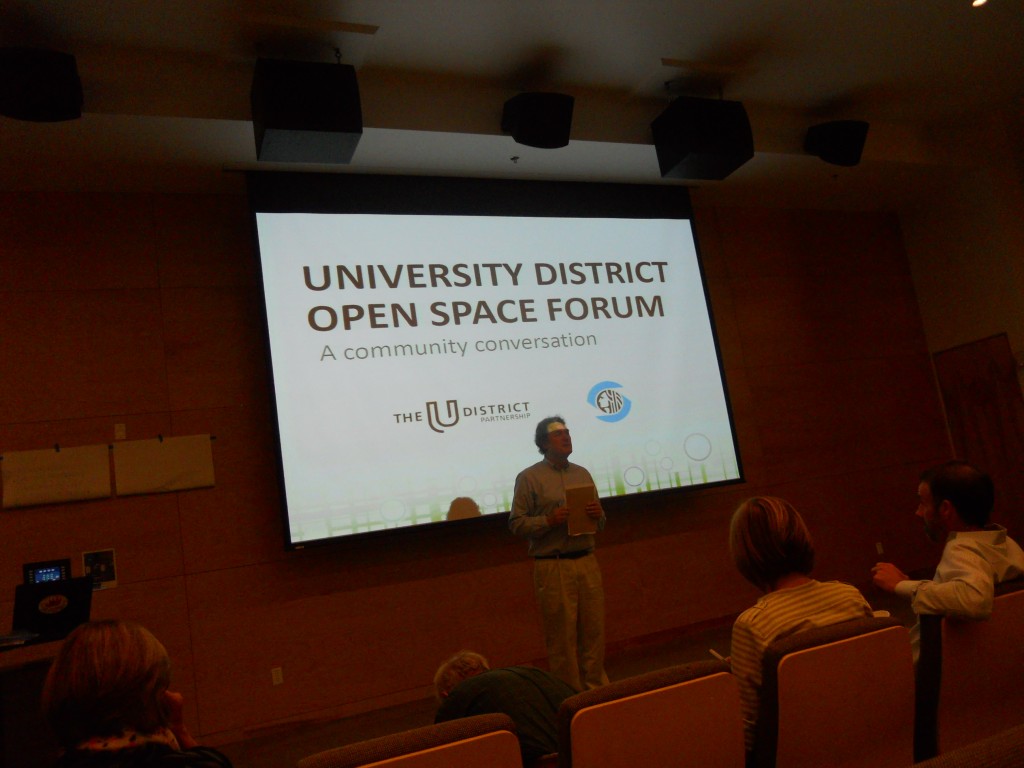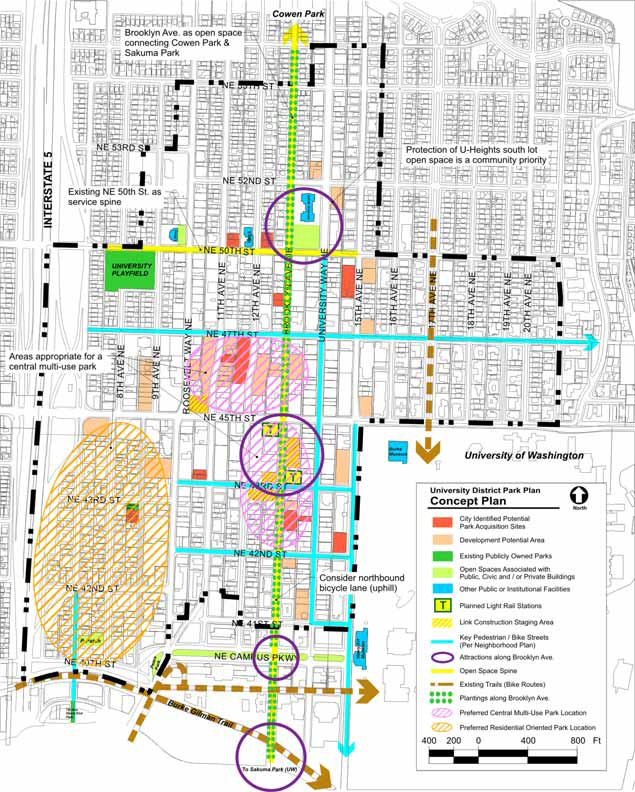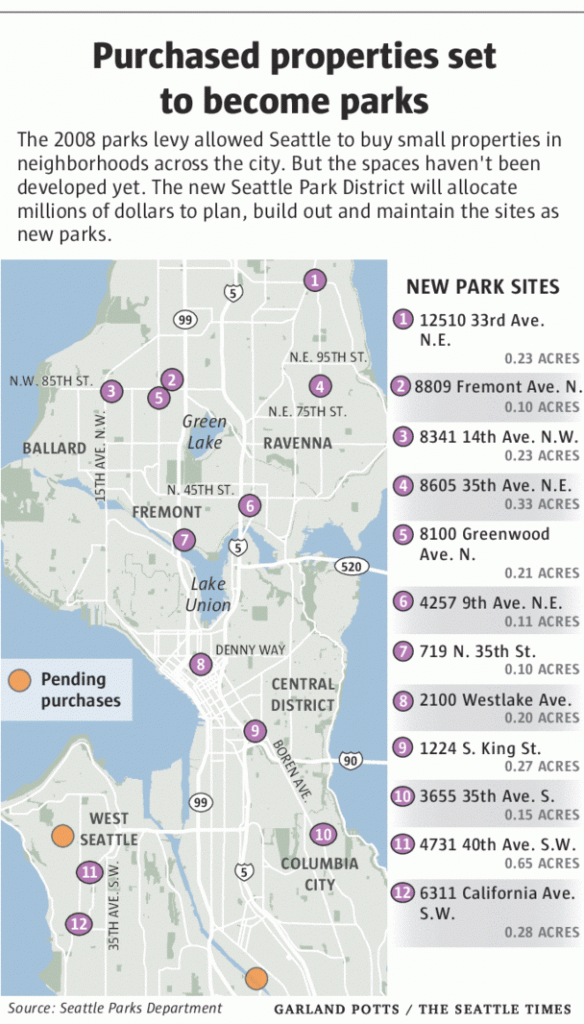
Some 100 University District residents and employees attended a new community forum on Tuesday night, which seeks to revitalize the neighborhood’s vision for its existing and future public spaces. Seattle’s Comprehensive Plan sets the standard for open space at 1 acre per 1,000 dwelling units and 1 acre per 10,000 jobs. Currently, the neighborhood stands at a 3-acre deficit by these metrics. With 1,500 residential units now under construction or planned, and an additional 4,000 units expected by 2035, the neighborhood’s open space deficit will surely grow. Amidst other planning processes, including a rezoning effort centered on the NE 43rd Street light rail station, the goal of the forum is to publish an updated public space plan for the University District that will guide future planning and development.
Public open space is critically important to the health of cities, especially as as growth and density increase. Such spaces can take a variety of forms, ranging from traditional parks and squares to shorelines, streets, and alleys. They provide an “outdoor living room” where people can gather, eat, relax, and play in the public sphere. Recent trends in urban design and landscape architecture recognize how location and coordination with surrounding land uses is critical to the success of public spaces. Local zoning also regulates how and where private development should provide open spaces, such as stoops, frontage plazas and gardens, rooftop green space, and interior courtyards. Although, these are often only incentive- or performance-based amenities.
The forum, which will have two more public meetings, has been in the making for at least a year. Rapid apartment growth in the post-recession period has stimulated debate, and the recent creation of the Seattle Parks District opens up new opportunities for funding. As a result, The U District Partnership (UDP) and the Seattle planning and parks departments hired consultants from the Pomegranate Center and MAKERS Architecture and Urban Design to lead public meetings, digest public input, and deliver recommendations on an open space plan.
The first meeting began with an introduction of the neighborhood’s spatial and temporal context and provided an update on public projects that are already underway. The City is planning to upgrade Brooklyn Avenue NE, NE 42nd Street, and NE 43rd Street to “green streets”–projects that were envisioned back in 1998 and before the imminent reality of a light rail station. The segment of Brooklyn Avenue NE between NE 45th Street and NE 43rd Street is tentatively designated as a “festival street” where a spinoff of the University Farmers’ Market can take place all week long. In collaboration with the University of Washington and Washington State Department of Transportation, the small waterfront park on Portage Bay (Sakuma Viewpoint) will be significantly expanded. Backers for a parklet on NE 43rd Street are currently fundraising, and the University Playground will soon be receiving improvements.
The facilitators then asked each member of the audience to answer a question: “What guiding principles or values do you propose for developing open space in the University District?” The responses ran the gambit and reflected the diversity of those in attendance. Residents value livability, sense of community, gateways and destinations, equitable distribution of green space, co-locating with transit and walking connections, pet friendliness, all-season usefulness, public art, and more. Then came the second question: “What kind of functions and activities do you envision?” Sitting, socializing, eating, sporting events, children and adults playing, gardening, water features, exercising, and quiet reflection all came up. Early on it became clear that there are a variety of needs. One common theme that residents supported was the importance of a central park space. Residents felt that such a space should be in proximity to the future light rail station and welcome the thousands of people who will be passing through it every day.
An important piece of new and improved open spaces will be maintenance and programming. Zori Santer, past director of Portland Parks and Recreation and now with MAKERS, said her experience in public parks planning and management has taught her many valuable things, but most especially this: government cannot be the sole provider of park services due to limited resources and lack of hyper-local park management personalization, especially for larger park spaces. Instead, many cities turn to non-profits and private community organizations to manage funding and programming for public spaces. Friends of the High Line in New York, the Woodall Rodgers Park Foundation in Dallas, or even Friends of Waterfront Seattle are prime examples. The UDP may play this role for future public spaces in the neighborhood. The UDP already manages the funds generated by a Business Improvement Area (BIA), which is an extra property tax on neighborhood businesses, and the former neighborhood Chamber of Commerce. The Partnership is proposing to expand the BIA boundaries, and if approved by property owners, it would generate $750,000 per year (up from only $140,000 per year) for funding events, marketing, street cleaning, and economic development.
As the second most active urban center in the Puget Sound region, the University District is set to become an even greater hub for business, academics, and social life over the next 20 years. With positive collaboration between residents and city government, the neighborhood can create a well-designed open space system which refines its unique identity. Stay tuned to this space for updates on future meetings slated October 30 and December 3. Each of these meetings will be held at 7pm on the University of Washington campus at Alder Hall Commons (1310 NE 40th Street).
Scott Bonjukian is a graduate student at the University of Washington’s Department of Urban Design and Planning. He writes about local and regional planning issues at his personal blog, The Northwest Urbanist.
Scott Bonjukian has degrees in architecture and planning, and his many interests include neighborhood design, public space and streets, transit systems, pedestrian and bicycle planning, local politics, and natural resource protection. He cross-posts from The Northwest Urbanist and leads the Seattle Lid I-5 effort. He served on The Urbanist board from 2015 to 2018.





